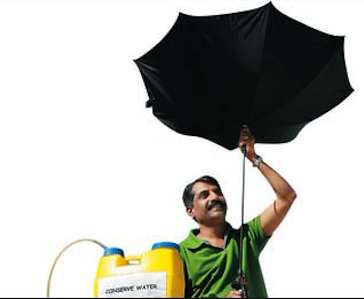
Excuses range from the cost of construction to lack of knowledge. Yet individuals who have incorporated such systems say that integrating water harvesting reduces costs over the long run.
“I have not used Utility water since 1994 in my home.” said A R Shivakumar. “With planning, rain water harvesting does not have to be expensive and space consuming.” Here are his tips:
TANK IT UP
Multiple rainwater tanks can be built depending on the flow of water. For instance, at Shivakumar’s home there is a 4500-litre rooftop tank. The excess water from this tank is allowed to run down rainwater pipes to a 25,000 litre sump built under the portico. If these two tanks fill up, then the extra water is allowed to seep into the ground.
A different set of rainwater pipes from the terrace takes water to a 10,000-litre tank built under the car park. The two underground sumps are interconnected and built at different depths so that water can flow from one to the other. The second sump is also linked to a borewell, which is used when the water in the tank gets depleted.
SIEVE AND FILTER
The first rainfall has a number of pollutants, so a first flush valve flushes out the dirt. Installing filtration systems before the water goes into the storage tanks is important.
The traditional one is the sand bed filter, with various beds of sand, gravel and pebbles, which strain out impurities. There are other smaller filters that are more effective and save space as well. For large spaces and heavier loads of water , you will need to install bigger tanklike filters to clean out the contaminants.
ZERO WASTAGE
Some of the water can be reused as well. For instance, water used in a washing machine can be collected in a separate tank and after filtering, used to flush the toilet. In cities with heavy rainfall, most rainwater harvesting sumps are not enough to hold all the water. You can ensure overflow outlets for all underground sumps.
The outlets can be diverted into large plastic drums buried underground with their bottom cut off. Also by not paving or concreting open spaces any rainwater falling onto the garden can percolate into the ground. You can also leave out open pots that will act as birdbaths when they fill up with rain water.
4 Responses
You CAN catch from any surface but you should put some thought into what the surface is made from. Some surfaces (such as tar/asphalt shingles) contain substances that have a high potential of leaching into any water that comes into contact with it. There are protective, potable water safe coatings available that can allow you to catch and use water without adding unwanted chems to your garden or shower water.
hi techstar, thank you for sharing ..very helpful and inspiring..any thoughts if this could work in a bldg?
great-fully…LikeMind
Catching water and using it for gardens and other household needs has been proven to work many times over. There is no such thing as the “wrong” rainwater unless it is from the chemical trails that our government puts in the air.
This article makes it sound as though any surface can be used safely. This is a very dangerous thought. Please take the time to research before setting up a rainwater system. Even if you are not drinking the water you can still have problems from simply watering your plants with the WRONG rainwater.